What types of Geogrid are available?
Since its inception back in the 1950s, geogrid design has constantly been evolving to better suit the needs of the construction and landscaping industries. There are now several different types of geogrid available on today’s market that are designed and manufactured for specific applications. But how do you know which kind of geogrid is right for your project? Well, let’s start by taking a look at the different designs available.
Geogrid Designs
As of November 2022, there are currently two main geogrid designs, each with different geometric and structural index properties. Understanding these differences is crucial for selecting the most appropriate geogrid for your project.
The primary concern when it comes to the suitability of a geogrid is the direction of its tensile strength, i.e. upon which set of ribs will the stress of the application need to be absorbed?
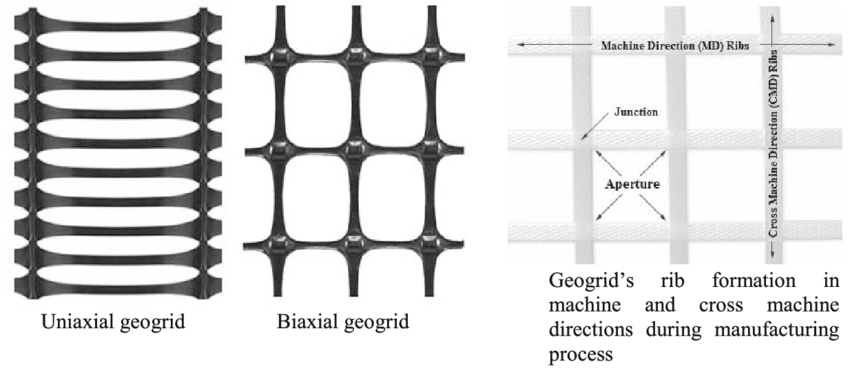
Uniaxial Geogrid
Uniaxial geogrids are designed to offer maximum stress resistance in a single direction, hence being called UNI-axial. This type of geogrid is formed through the stretching of ribs in the machine direction, giving it a high tensile strength along that axis with, typically, rectangular apertures rather than square. Uniaxial geogrids are usually more economical than the other types of geogrid because they are the simplest design to manufacture. However, they aren’t suitable for ground stabilisation applications, such as under pavements and roads, where stresses must be dispersed in both directions. What they are perfectly suited for, however, are wall and slope applications where the primary reinforcement needs to be against the forces pointing either towards the face of a wall or down a slope. Structures such as retaining walls, steep earthen slopes, landfill liner systems, and soft soil embankments can all benefit from geogrid reinforcement.
Key features of Uniaxial Geogrids:
Rectangular aperture design
High tensile strength in one direction (machine direction)
More economical manufacturing process
Increases soil confinement lateral restraint
Ideal for wall and slope reinforcement applications
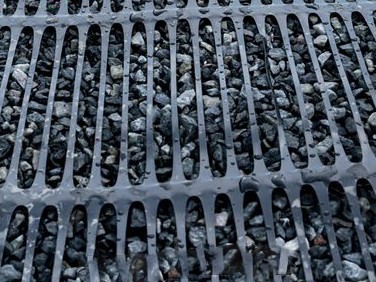
Biaxial Geogrid
Biaxial geogrids are designed to offer an equal balance of stress resistance in two directions, hence being called BI-axial. This type of geogrid is formed through the stretching of ribs in both the machine and transverse directions, giving it a high tensile strength along both axes with the more typical square aperture shapes. This gives biaxial geogrids the ability to distribute loads over more expansive areas than usual, allowing for an increased capacity in base stabilisation applications. While suitable for use in wall and slope applications, the more complex design of the biaxial geogrid requires a more costly manufacturing process, which in turn makes for a more expensive, and therefore less economical, product than the uniaxial design for that purpose. Biaxial geogrids are much better suited to base stabilisation applications such as in the construction of car parks, working platforms on weak subgrades, construction haul roads, foundations for roadbeds, permanent unpaved roads, railroad truck beds, and airport runways.
Key features of Biaxial Geogrids:
Square aperture design
High tensile strength in two directions (machine direction and transverse direction)
More rigid than uniaxial geogrids
Helps reduce aggregate layer thickness
Ideal for subgrade stabilisation and road/pavement optimisation applications
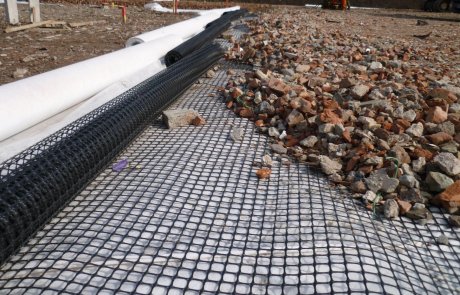
Alternate Geogrid Design Options
While Uniaxial and Biaxial are the two primary types of geogrid that you will find supplied by most manufacturers, there are also two alternatives worth noting:
Triaxial Geogrid
An evolution of the biaxial design, triaxial geogrids have been developed by Tensar for improved performance in soft soil applications. Using a triangular aperture design instead of squares, the TriAx® geogrids have additional diagonal ribs that form a hexagon pattern of triangles that increases its in-plane stiffness.
Geogrid-Geotextile Composites
In heavy silt applications, a layer of geotextile fabric is generally recommended to separate the subgrade and base material to prevent the silt from travelling up over time. To save time during installation, some geogrid manufacturers offer a composite product that combines a biaxial geogrid and a geotextile fabric, providing both separation and stabilisation in one roll.
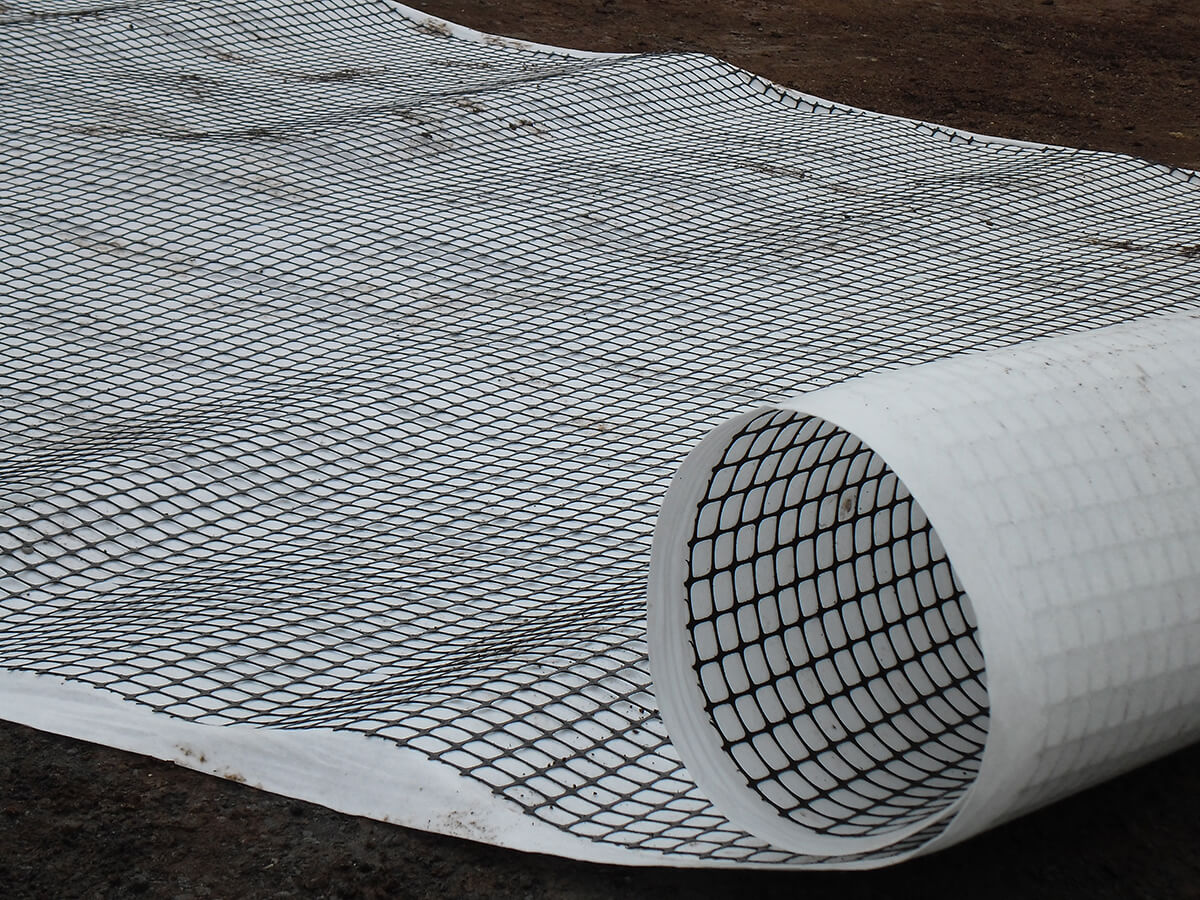
Geogrid manufacture types
The other decision you have to make when choosing the right geogrid for your project is the manufacturing type. Typically, most polymer geogrids are either extruded, woven, or bonded, but what is the difference, and does it really matter? Let’s find out by taking a closer look at each one.
Extruded Geogrid
Extruded geogrids, also known as “punched and drawn” geogrids, are the descendants of the original unitised geogrids invented by Dr Mercer. They are made from flat sheets of extruded plastic, usually high-density polypropylene or polyethylene, that are passed through a punching machine to cut out the desired aperture pattern. After this, the material is then stretched in the desired direction (machine direction for uniaxial geogrids and both machine and transverse directions for biaxial geogrids) to develop the required tensile strength. Extruded geogrids are more rigid than their counterparts and can be more expensive, but they do perform exceptionally well in high-tension applications.
Woven Geogrid
Woven geogrids are a more flexible, textile-like alternative to extruded geogrids. They are made from polyester or polypropylene yarns (hundreds of continuous fibres gathered together) that are woven (or knitted) into longitudinal and transverse ribs to create the geogrid apertures. The resultant grid structure is then typically given a protective coating of either bitumen, latex, or PVC. Woven geogrids are available as either uniaxial or biaxial designs and offer high strength at low elongation. They tend to be a cheaper option than extruded geogrids and can therefore offer cost savings where high performance isn’t required.
Bonded Geogrid
Bonded geogrids are a relatively new development. They are made from flat ribs of extruded polyester or polypropylene that are passed through rollers to bond them together, typically using heat. This is done with automated machines that can run at different speeds to stretch the ribs in the desired direction for the desired tensile strength.
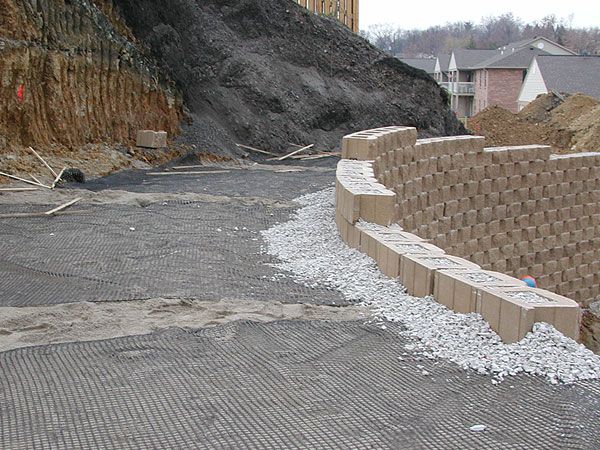
Which type of Geogrid is best?
Despite there being a fairly wide variety of geogrid types available to choose from, which may seem a little bit daunting at first glance, the choice of geogrid design largely depends on your application - choose uniaxial for slope reinforcement and biaxial or triaxial for ground stabilisation. In terms of the manufacturing type, they all produce high-quality products that are fit for use in all geogrid applications, so it can largely come down to price and availability. For roadbed applications, however, extruded “punched and drawn” geogrids have consistently tested well and are often considered the best choice. If you have any doubts about which type of geogrid would be best for your project, however, it is always best to speak to a professional. Knowing the right tensile strength required for the intended application is the key to success, and it can be tricky if you aren’t 100% sure what you are doing.

What are the benefits of using Geogrid?
As already discussed, there are a great many benefits to using geogrids in construction and landscaping projects. Some of the key points to remember about geogrids, however, are that they:
Can be easily installed in any weather conditions.
Are highly resistant to chemicals, UV radiation, soil microorganisms, and mechanical damage.
Promote soil stabilisation.
Provide tensile reinforcement for foundations.
Offer greater resistance to settling and erosion.
Enable a more efficient distribution of loads.
Increase load-bearing capacity of soft sub-soil.
Increase the longevity of projects and reduce the need for maintenance.
In all types of construction and landscaping applications, installing geogrid can help to:
Reduce project costs by allowing you to use less expensive fill materials without compromising the integrity of the build.
Ensure proper land utilisation by increasing the strength of unsuitable soils and allowing them to meet the required properties for construction.
Reduce asphalt maintenance needs and increase the lifespan of roads and pavements by reducing the effects of differential settlement.
Reduce the aggregate layer thickness in unpaved roadways without a loss in performance.
Make construction and landscaping projects safer by increasing the bearing capacity of weak subgrades.
Enhance the safety of slopes by increasing the soil strength.
Reduce the excavation depth required on otherwise unsuitable subgrades
Reduce the amount of foundation material required in railway projects and limit rail ballast movement and displacement by increasing the bearing capacity.
Provide a more cost effective alternative to poured concrete for working platforms.
For a better idea of the potential savings geogrids can provide, please check with our sales team by email or phone.


